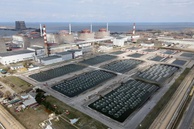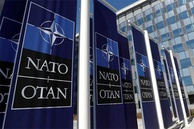The collapse of the dam at the Kakhovskaka hydroelectric power station (HPP) served as a possible scenario prescribed for the Zaporizhzhya NPP - a long-term fire impact on an infrastructure facility that will lead to disruption of its operation, accumulation of critical and emergency situations and, eventually, to its destruction.
The chronology of events compiled by military expert Boris Rozhin, who notes that the sheer fact that over the past year the Armed Forces of Ukraine had launched almost a dozen rocket attacks on the Kakhovskaya hydroelectric power station clearly answers the question of who actually destroyed the station. “The Kakhovskaya hydroelectric power station came under the control of the Armed Forces of the Russian Federation on the very first day of the special military operation, on February 24,” Rozhin wrote. “Since then, the city of Novaya Kakhovka and the station itself have been subjected to regular shelling by the Ukrainian Armed Forces. There were over ten attacks on the HPP, mostly by US-supplied HIMARS multiple rocket launchers.”
Vladislav Nazarov, a spokesperson for Ukraine’s Southern Operational Command, and Ukrainian Major General Andrei Kovalchuk admitted the shelling.
- July 8, 2022. Ukrainian troops launched a missile attack on the Kakhovskaya HPP. Air defense managed to repel the attack, but there were victims, said Kirill Stremousov, deputy head of the Kherson military-civilian administration (MCA).
- July 18, 2022. As a result of an attack on the hydroelectric power station, the control room of the lock was damaged. Fragments damaged the gas pipeline, thus leaving half of the right bank of the Kherson region without gas supply, said Viktor Vasilyev, the press secretary of the MCA of the Kakhovka district of the Kherson region.
- July 23, 2022. The Armed Forces of Ukraine fired seven shells into the area of the Kakhovskaya hydroelectric power station, causing damage to the station, the Kakhovka district MCA reported.
- July 24, 2022. The hydroelectric power station came under HIMARS fire again, suffering damage to its infrastructure, the head of the district administration, Vladimir Leontyev, said.
- July 30, 2022. On the night of July 29-30, the HPP was once again attacked by HIMARS. The air defense system shot down all the incoming rockets, Leontyev said.
- August 12, 2022. Renewed shelling occurred when a bus with civilians on board was approaching the station. Three out of the station’s six turbines failed, Rossiya-1 television reported. The hydroelectric power station was switched to operation in emergency mode at just half of its capacity. “We work in a very dangerous mode. The fighting threatens not only the lower reaches of the Dnieper, but also its upper reaches,” Arseniy Zelensky, deputy director of the Kakhovka HPP, said.
Vladislav Nazarov, the representative of the Southern command of the Armed Forces of Ukraine, confirmed the strikes on the dam of the Kakhovskaya hydroelectric power station, aimed at destroying the bridge. - September 8, 2022. The regional authorities announced that the Kakhovskaya HPP and its access roads were being attacked by the Armed Forces of Ukraine.
- September 10, 2022. The Armed Forces of Ukraine fired on Novaya Kakhovka and the hydroelectric power station with HIMARS. The air defense systems shot down all the incoming missiles, the city's MCA announced on the TG channel.
- October 18, 2022. “The Antonovsky Bridge and the dam of the Kakhovskaya HPP were damaged by HIMARS rockets,” Sergei Surovikin said on October 18. Kyiv is preparing "to strike at the dam of the Kakhovskaya hydroelectric power station," he added.
- October 21, 2022. Russia called on the UN Security Council to prevent Ukraine's provocative attacks aimed at destroying the hydroelectric power station. “The Ukrainian Armed Forces have been shelling the city of Novaya Kakhovka for five months now. Up to 120 missiles arrive each day,” the statement said.
- October 24, 2022. The Armed Forces of Ukraine fired 19 HIMARS and Alder missiles on Novaya Kakhovka. Part of the missiles were shot down, but three hit the hydro, journalists were told by the Kherson region emergency services.
- November 6, 2022. Ukrainian troops fired six HIMARS rockets at the HPP. Five were shot down and one hit the lock of the dam, which was damaged, a representative of the emergency services of the Kherson region said.
- December 29, 2022. Major General Andrey Kovalchuk, commander of the Armed Forces of Ukraine in the Kherson region, also admitted the shelling of the hydroelectric power station. “Ukrainians launched a test strike with HIMARS on one of the locks of the Novokakhovskaya dam, punching three holes in the metal to see if the Dnieper water could rise high enough to block Russian crossings, but would not flood the nearby areas of the village. The test was successful,” the Washington Post quoted him as saying.
- March 14, 2023. “The Kakhovskaya HPP is not only regularly shelled by artillery, but also attacked by snipers. Ukrainian special Ops units tried to penetrate the territory,” Leontyev said. “The HPP is constantly under attack,” he added.
- April-May 2023. The water level in the Kakhovskaya reservoir rose dramatically from 14 to 17.5 meters, according to Theia-land data.
- May 28-June 5, 2023. A section of the road collapsed as a result of water pressure and previous destruction, NYT, WP and FT journalists noted, citing satellite imagery.
- June 6, 2023. Water pressure, accumulated damage and new explosions led to disaster. Eleven out of 28 spans of the station collapsed. Water began to be discharged uncontrollably and reached such a level that it flooded the station.” [i]
Obviously, given the damage from previous bombardment, even a single additional artillery shell or rocket hitting the lock could start the process of destruction of the dam. Which is exactly what happened.
Information war is a key factor in the Ukrainian crisis. Kyiv’s propaganda is extremely active and unanimous in trying to make everyone believe that the dam was blown up by the Russians themselves. The notion of Crimea “left without water” immediately comes into play, along with information about water shutdowns in some Crimean cities, which does not speak of any shortage, but is the usual modern-day practice of network replacement. Regarding the situation with water in Crimea, reservoirs are filled (to 80 percent, compared to previous years, when they were filled by 15-20 percent).
New water intakes have been introduced that fully meet the local needs. The peninsula lived without Dnieper water for eight years. Modernization, construction and repair of water conduits is underway - something unseen during Crimea’s entire Ukrainian period. For example, the replacement of 17 out of 1,200 km of water pipelines in Simferopol has already resulted in 30,000 cubic meters of water saved each day.
The water intake of the North Crimean Canal is located above the hydroelectric dam and was not damaged.
Misinformation about the destruction of the Kakhovskaya dam and all the information and psychological spin about panic in Crimea, water cuts in the cities of the peninsula, etc., completely expose the Ukrainian regime.
The nuclear factor of the Ukrainian crisis also comes in very clearly here with certain risks created for the Zaporizhzhya NPP, primarily regarding the cooling of spent fuel storage facilities. Currently, the situation is under control as there are options for filling the cooling system with water.
Five units are in cold shutdown mode and one is in hot shutdown mode. The water level in the cooling pond has not changed and remains at 16.67 meters. “The water cooling the spent nuclear fuel pools is a closed circuit that has no contact with the environment and the water of the Kakhovka reservoir. The heat removal system to the final heat sink can be replenished both with water from the Kakhovka reservoir and several alternative sources,” said Yury Chernichuk, director of the Zaporizhzhya NPP. “The situation is being controlled by the staff of the nuclear power plant.” [ii]
At the same time, Ukrainian propaganda is actively playing up out the topic of a nuclear catastrophe at a “Russian-controlled” nuclear power plant as a result of the collapse of the dam, allegedly blown up by the Russians.
Through the information and psychological channels and all sorts of liberals, often with Russian citizenship, they try to make people believe that “it doesn’t matter who blew up the hydroelectric power station; what matters is who started the war - he is to blame,” and that “who controls the infrastructure object is the one who is responsible for everything that happens there."
When assessing the situation around the Kakhovskaya HPP, one should add here the military factor. Chances are that the Ukrainian side is not particularly eager to counterattack, and the flooding in the Kherson region is a justification for the delay and narrowing the territory of a potential offensive. The Western media argues that "the Russians in the Kherson direction secured themselves from a counteroffensive thanks to the rise of water and flooding of territories." It is obvious, however, that this is an attempt by the Ukrainian side not only to discredit Russia and blame it for an environmental disaster, but also an attempt to point to the potential damage to Crimea (a new version of the water blockade), and an aggravation of the nuclear factor (problems of cooling the systems of the Zaporizhzhya NPP). There is also an attempt to flood the Russian defensive positions on the Kherson track. At the same time, the shallowing of the Kakhovka reservoir, the narrowing of the Dnieper in many places opens up opportunities for Ukrainian Special Ops unit attacks in different places, including on nuclear power plants.
The Ukrainian crisis is a highly hybrid development. Therefore, one should take into account events that, when analyzed, seemed to be on a different plane. Thus, attacks by the so-called "Russian rebels" on the Belgorod region are an integral part of a hybrid confrontation.
On June 4, the Ukrainian telegram channel "Ukraine 24/7" came up with the following messages:
8 am - “Russians are shelling the city from Grad [multiple rocket launchers], the police station is on fire;” “they feared that the rebel tanks were already in Shebekino.”
10 am - "The police in Shebekino came under Grad attack by the RDK [Russian Volunteer Corps]” (an organization banned in Russia). [iii]
These two messages by the Ukrainian telegram channel came just two hours apart. During these two hours, the desire to show how “the Russians are shelling themselves out of fear” in Shebekino grew into a desire to show the successes of the supposedly RDK.
What is true in all of this is that Shebekino is under attack from the Ukrainian side. The rest are elements of an absolutely cynical and reckless information war. This is evidenced by how fast the Western media jumped in highlighting the “combat path and successes of the Russian rebels”: ‘The Times published an interview with one of the leaders of the traitor detachment that took part in the attack on the Belgorod region, in which “literally everything is fine,” starting with the headline itself. True to the classic scheme used by enemy propaganda, the groups supervised and controlled by the Kyiv special services are called "pro-Ukrainian partisans." This is a clear attempt to distance Ukraine from what is happening and pretend that what we see is a “private initiative of fighters against Putin” – a typical pattern within the framework of a hybrid war. In addition, the leader of the traitors shared his truly Napoleonic plans - to capture Moscow immediately after the Crimea, which the Armed Forces of Ukraine should take for him. (...) Just how fast the Western media started to promote the neo-Vlasovites was a perfect demonstration of the essence of such units. The greater the media exposure, the better the chances for Kyiv to present traitors as independent actors to the Western public and thereby legitimize their existence for the broad masses.” [iv]
Some details of the interview are still worth reading. The Times interviewed a certain Maximilian Andronnikov with the call sign "Caesar," one of the members of the Ukrainian sabotage group that attacked the Belgorod region. This is what he says: “We will carry out these raids until we have our own piece of Russian territory ... once this happens, we will quickly increase our forces and numbers, and this will end in a Kremlin campaign.” [v] Besides, he boasts of the Legion's "victories" and talks about supposedly thousands of recruits eager to join his terrorist gang. The role of the West in all of this is revealed by the interviewed himself: ‘Caesar also notes the alleged abundance of weapons available to the Legion: US mortars, armored vehicles, Stinger MANPADS, anti-tank systems and highly effective reconnaissance drones. And this despite the fact that Washington did not authorize the transfer of equipment to "military organizations" that allegedly are not part of the Ukrainian Armed Forces. Washington is apparently trying to sit on two chairs – to present itself as Kyiv’s exclusive sponsor, and to kill more Russians.’ [vi] In a word, in their attempt to justify the attacks by the Legion controlled by the Armed Forces of Ukraine, the Western media is passing off its actions as “the liberation of Russia,” and has stooped to the point of interviewing non-humans, whose words are worth nothing.”
Within the framework of this war, any pretexts are created and used in order to demonstrate the existence of some "Russian rebels." And since there are “rebels,” this justifies strikes on Russian territory for Western viewers and readers, because since “they are Russian rebels, it means they can fight against the regime in Russia.”
The aftermath of the destruction of the HPP dam, which is not the largest around, is an example of the consequences of the destruction of an infrastructure facility - flooding of territories, an ecological disaster, forced resettlement of people, let alone the impact on the economy. Since the facility remains on the line of contact, there are currently no prospects for its restoration.
Another lesson is that the destruction of one facility can cause cascade destruction of related infrastructure as this can threaten the operation of the Zaporizhzhya NPP and the North Crimean Canal.
The hybrid confrontation will continue; first, between the "rebels" and the undermining of the hydroelectric power station - the desired information effect, and second – as attempts to put pressure on Russia. Ukraine is seen by the West as the most convenient weapon against Russia, the main proxy force. Ukraine for the West is a vortex sucking in money, resources, equipment, and undermining the economy. And all this for the sake of turning this vortex into a syringe used for a lethal injection into the body of the Russian Federation.
The views of the author are his own and may differ from the position of the Editorial Board.
------------------------------------------------------------------------
[i] https://t.me/boris_rozhin/88205
[ii] https://t.me/StranaRosatom/5648
[iii] an organization banned in Russia
[iv] https://t.me/readovkaru/3435
[v] https://t.me/readovkanews/59873
[vi] https://t.me/readovkanews/59873
read more in our Telegram-channel https://t.me/The_International_Affairs

 19:59 14.06.2023 •
19:59 14.06.2023 •


























